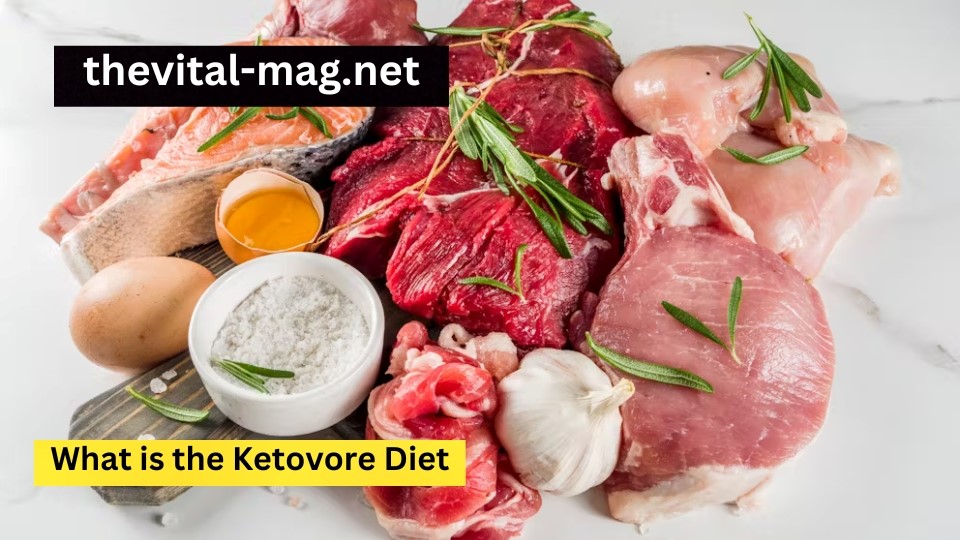It’s cracked. What is the Ketovore Diet? is a combination of the best of keto and non-vegetarian diets. If you follow diet trends you may have heard about two things. The ketogenic diet puts your body into ketosis by limiting carbohydrates and increasing fat intake. When in a state of ketosis your body burns fat for energy instead of relying on carbohydrates.
A non-vegetarian diet, on the other hand, consists of consuming only animal-based foods such as meat, eggs, and dairy products. And completely abstain from all plant-based foods…Keto diet! It primarily involves feeding animals high protein foods. There are also alternatives to low-carb, plant-based diets. Basically this diet is a low-carb, high-fat diet that focuses on meat nutrition.
While still providing some carbohydratesKey Components of the Ketovore Diet,okay, so let’s talk about the core pieces of the Ketovore Diet. It’s all about simplicity when it comes to food, but there are a few important elements:
Key points
- High-fat foods: You’re going to be loading up on healthy fats from animal sources like butter, tallow, and fatty cuts of meat. Fats are crucial because they’re what your body will burn for fuel when you’re in ketosis.
- Low-carb intake: Carbohydrates are kept at a bare minimum. You’ll want to aim for fewer than 50 grams of carbs per day—this keeps you in nutritional ketosis and helps with fat adaptation.
- Protein-based diet: You’ll also get plenty of protein from animal products, like beef, pork, lamb, chicken, and eggs. Protein is essential for muscle repair and overall health, especially if you’re active.

Foods to Include in Your Ketovore Diet
The beauty of the Ketovore Diet is how straightforward it is. It’s heavily based on animal-based meals, and there’s a clear distinction between what you can and can’t eat. Here are some key foods you’ll want to include:
| Food Category | Examples |
| Animal-based proteins | Beef, pork, lamb, chicken, turkey, and eggs |
| Healthy fats | Butter, ghee, tallow, duck fat, olive oil |
| Organ meats | Liver, heart, kidneys (incredibly nutrient-dense) |
| Low-carb vegetables | Leafy greens like spinach, kale, and broccoli (optional) |
Most of your meals will come from animal-based nutrition, with organ meats providing a high concentration of essential vitamins and minerals. Although veggies are optional, if you include them, make sure they’re super low-carb like leafy greens.
Foods to Avoid on a Ketovore Diet
If you’ve ever been on a low-carb diet or even keto, you’ll recognize some familiar foods to avoid. But the Ketovore Diet goes a step further in eliminating certain things:
| Avoid These Foods | Why |
| Carbohydrate-rich foods | Bread, pasta, rice, and grains are too high in carbs and will throw you out of ketosis. |
| Plant-based foods | Fruits, legumes, and most vegetables are high in carbohydrates. Stick to very low-carb veggies if any. |
| Processed foods | Processed meats, snacks, and junk food often contain hidden sugars, additives, and carbs. |
The focus is on zero-carb or extremely low-carb foods, so anything high in sugar or starch is a no-go. Cutting out these foods helps maintain blood sugar control and reduces insulin resistance.
Health Benefits of the Ketovore Diet
I’ve found that one of the most exciting parts of the Ketovore Diet is the health benefits it can offer. Here’s what stood out to me:
- Weight loss: Because you’re eating fewer carbs, your body enters ketosis and begins burning fat for energy. This often leads to noticeable fat loss. According to studies, people on a low-carb, high-fat diet tend to lose more weight than those on low-fat diets .
- Improved mental clarity: With ketones as the brain’s fuel, many people report experiencing better focus and sharper thinking. I noticed the same on my low-carb journey.
- Metabolic health: This diet helps with insulin sensitivity and blood sugar levels, making it a good option for people with diabetes or metabolic syndrome.
- Increased energy levels: With your body burning fat instead of carbs, you avoid the highs and lows that come with sugar spikes and crashes.
Potential Drawbacks of the Ketovore Diet
Let’s be real—no diet is perfect, and the Ketovore Diet has its potential downsides too:
- Nutrient deficiencies: Since you’re cutting out most plant-based foods, you could miss out on certain nutrients like vitamin C, magnesium, and fiber. To avoid this, some people add supplements to their diet or carefully choose foods like organ meats to fill the gaps.
- Digestive issues: Switching to a meat-heavy diet might cause some initial digestive discomfort, especially if your body isn’t used to processing a lot of fat. You might experience constipation or bloating initially, but this usually settles once your body adapts.
- Social limitations: Let’s face it—this isn’t the easiest diet to follow when you’re out with friends or at social gatherings. Most restaurant options are filled with carbs, and it can be tough to stick to your diet unless you plan ahead.
How to Transition to a Ketovore Diet
When I first considered going Ketovore, I was a little worried about how to start. If you’re like me and don’t want to dive headfirst, there are a few ways to transition gradually:
- Reduce carbs gradually: Don’t feel like you need to cut out all carbs overnight. Slowly reduce them over the course of a few weeks by swapping high-carb foods for fat-based nutrition like butter, ghee, or fatty cuts of meat.
- Increase healthy fats: Gradually start increasing the amount of healthy fats in your diet, especially from animal sources. Think of adding butter to your veggies or using more olive oil in your cooking.

Meal Planning for the Ketovore Diet
One thing I’ve found really helpful is meal planning. Having a go-to list of meals can make life so much easier. Here are some sample ideas to get you started:
| Meal | Food Ideas |
| Breakfast | Scrambled eggs cooked with butter and bacon. |
| Lunch | Grilled steak with a side of sautéed spinach |
| Dinner | Pork chops with a side of broccoli and melted butter |
| Snack | Hard-boiled eggs or a handful of pork rinds |
Keep your meals high-protein and high-fat, and always have easy snacks on hand to avoid any temptations to grab something high-carb.
Common Myths About the Ketovore Diet
As with any diet, there are myths floating around. Let’s set the record straight on a couple of them:
- Myth: “Eating too much fat causes weight gain”
Fact: When following a low-carb, high-fat diet, your body uses fat for fuel. Eating dietary fat doesn’t mean you’ll automatically gain weight—it’s about the balance between fats and carbs. - Myth: “It’s unhealthy to eat only animal products.”
Fact: Animal-based foods like beef and organ meats are incredibly nutrient-dense. If you focus on eating a variety of cuts and include things like liver or kidney, you’ll get many essential vitamins and minerals.
The Role of Supplements in a Ketovore Diet
If you’re going full Ketovore, you might need a little help from supplements to stay balanced, especially in the early days. Here are some you might want to consider.Top of Form
- Magnesium: Helps prevent muscle cramps and supports a healthy metabolism. I noticed that when I started the diet, I’d occasionally get cramps, but adding magnesium helped.
- Vitamin D: If you’re not getting enough sun, vitamin D can help support immune function and bone health.
- Omega-3s: These are important for balancing the omega-6 fatty acids you’re getting from meats. If you’re not eating a lot of fatty fish, consider a supplement to get your omega-3s.
Monitoring Your Progress on a Ketovore Diet
Keeping an eye on how your body is responding to this diet can help you make tweaks along the way. Here are a few ways I’ve found helpful:
- Track your meals: I found that keeping a food journal helped me see patterns and make adjustments where needed. It’s a great way to stay accountable and monitor how your body reacts to different foods.
- Check in with a doctor: It’s always a good idea to monitor your health with regular blood tests, especially when trying a diet that’s focused on high-fat consumption. You want to make sure things like cholesterol and blood sugar levels are in check.
Also Read Our Article on Nutrition and Diet: Mashed Potatoes Plain Mushrooms: A Comfort Food Delight
FAQs
Is the Ketovore Diet safe for everyone?
Not necessarily. While many people thrive on this diet, it’s always a good idea to consult a healthcare provider before making any major dietary changes—especially if you have pre-existing health conditions.
Can I lose weight on a Ketovore Diet?
Absolutely. The high-fat, low-carb combo naturally promotes fat loss, as it encourages your body to burn fat for fuel.
What are some easy recipes for beginners?
My go-to recipe is grilled steak with a generous amount of butter and a side of spinach. Another favorite of mine is a plate of scrambled eggs cooked in ghee, served with crispy bacon.
Conclusion
There’s a lot to love about the Ketovore Diet if you’re into low-carb, high-fat eating and enjoy a meat-heavy lifestyle. It combines the best of keto and carnivore diets, offering benefits like weight loss, mental clarity, and better metabolic health. While there are challenges, like potential nutrient deficiencies and social limitations, careful planning and smart supplementation can help.
Whether you’re curious about fat loss, mental clarity, or just experimenting with new ways of eating, the Ketovore Diet is worth a try. Keep track of your progress, listen to your body, and enjoy the simplicity of animal-based nutrition!






